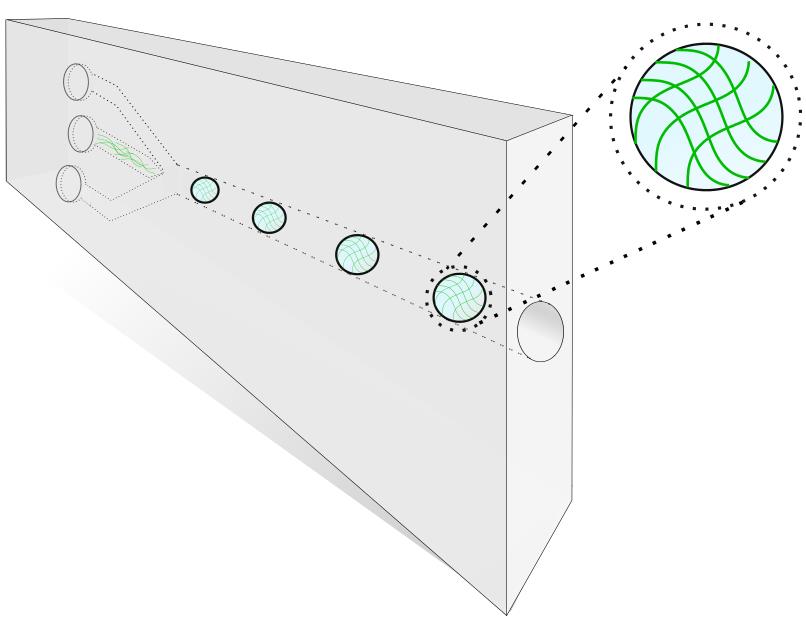Microfluidics - Department of Physics
Microfluidics
Microfluidics
Microfluidics is plumbing at the microscale - controlling fluids in channels with a diameter comparable to a human hair or smaller. We are a research team using micro- and nanofluidic systems to study biological interactions and automate complex processes for biomedical applications.
Research topics
Droplet-based microfluidics
Traditional medical treatment of various cancer types can be more destructive than beneficial since the treatments come with a great cost of reduced quality of life; some procedures, such as chemo or radiation therapy, may even cause lethal side effects.
Another widespread disease, diabetes mellitus I, is as of today an incurable disease. Patients with the diagnosis are dependent on frequent insulin supplements due to malfunctions in the insulin-producing beta-cells found in the pancreas. Other individuals struggle with fragile bones due to a syndrome called osteoporosis.

The projects aim to develop materials for more sophisticated treatment procedures enabling localized cancer treatment, long-lasting insulin supplements, as well as bone regeneration by application of droplet-based microfluidic devices (Fig. 1). By utilizing the biocompatibility and gel formation features of the polysaccharide alginate, scaffolds for drug- and cell-encapsulation can be synthesized for cancer, diabetes type I and osteoporosis treatment.
High-throughput microfluidics for mechanoprofiling of microgel beads and cells
Changes to the mechanical properties of cells can be an indication of different diseases and illnesses, such as malaria for red blood cells or cancer. Changes in the Youngs modulus/stiffness of red blood cells will affect their ability to perform vital functions as they are required to pass through capillaries half their diameter and must therefore be flexible and be able to deform to do so. A disease such as malaria results in an increase in cell stiffness which can prevent this from happening. Cancer cells on the other hand are typically more flexible than healthy cells, allowing them to more easily enter into the blood stream and spread in the metastasis process. The mechanoprofiling of cells is therefore an important diagnostic tool. Traditional mechanoprofiling of cells typically involve the use of advanced equipment such as atomic force microscopy (AFM), micro pipette aspiration and optical tweezers. Although these techniques can provide an estimate of the elasticity of the cell, there are considered low-throughput techniques, as they can only evaluate a few cells per minute. With the use of microfluidic channels, a high-throughput device can be developed.
In collaboration with partners at Dept of Biophysical Microstructures, Inst of Nuclear Physics Polish Academy of Sceinces, Krakow Poland, we aim to develop a high-throughput microfluidic device capable of microgel bead and cell deformation, coupled with on chip analysis and sorting. Microgel beads, with known elasticity, will first be fabricated and used as a calibration material, as this will link elasticity to deformation for later cell mechanoprofiling. This will involve both droplet and continuous flow microfluidic techniques, with channel fabricated from photo- and soft-lithography (PDMS) fabrication methods.
Passive Mixers
The laminar flow associated with microfluidic devices often results in diffusion limited mass transport. This will result in long mixing times and thus long microfluidic channels to achieve complete mixing of multiple flows, to overcome this challenge two district mixing methods has been developed, Passive or Active. Active methods, such as SAW, requires additional instrumentation whilst passive mixers facilitate mixing based on geometrical changes to the microfluidic channel. One such change is the introduction of structures to one or more walls of the channel, such as the ceiling.
This project evaluated the efficiency of several such ceiling based passive microfluidic mixers. Multi-layer photolithography methods were implemented to fabricate several different passive microfluidic mixers. The flow was evaluated using fluorescence and confocal microscopy, where the reduction in the diffusion distance amongst the developed laminae depending on the mixer used was analysed.
